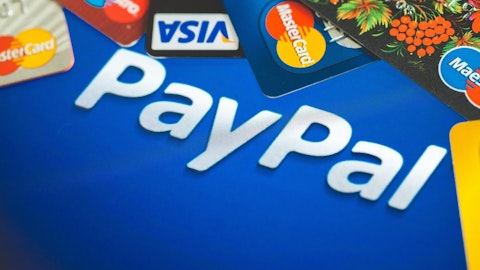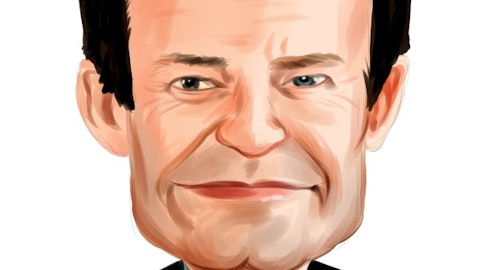Dara Khosrowshahi : And then in terms of the frequency of trips, there are really four factors that I would point to. First of all, we just talked about our membership program. As we increase the number of members in our member base and the coverage of members who tend to buy more, who tend to buy more frequently, just mathematically, you’re going to drive frequency up. Second for us is the power of the platform. We are constantly cross-promoting between Mobility and Delivery, and essentially sending free or cheaper traffic from one platform to the other in a personalized targeted way as well. And so you should expect more opportunities for us to upsell and cross-sell in an intelligent way driven by AI and machine learning. The third is the breadth of the product that we offer.
So for example, with Mobility, with Reserve and low cost, Reserve has been a huge shift for us. And we estimate that 50% of Reserve trips are actually incremental, they wouldn’t have happened otherwise. The other 50% are upsell, so to speak. They are more profitable than on-demand trips. Grocery is another example of new products that we are adding on at higher selection, driving higher frequency as well. And then last and certainly not least is the reopening, right? The shift of spend from products to services is benefiting us. So there is a tailwind in terms of people getting out, people shopping more, people going out to dinner more, et cetera, and that is helping our business as well. So it’s really membership, platform, new products, and then the macro environment that’s helping frequency.
And we expect to see that frequency, that 5.4%, continue to increase over a period of time. And there’s no reason that I see why we shouldn’t hit or exceed our all-time highs over a period of time.
Brian Nowak : Great. Thank you both.
Balaji Krishnamurthy : You’re welcome. Next question?
Operator: Your next question comes from Ross Sandler with Barclays.
Ross Sandler : Hey, guys. Just a question about the upfront fare and upfront destination technology that you shipped. So you noted in the letter that you saw about a 4% increase in conversion. So I guess just some context around that. How does this innovation compared to others that you’ve shipped in the past in terms of like magnitude of overall impact? And as you look forward over the next couple of years, do you see other technology updates that — in the future, that could be as impactful as what you’ve done with upfront? Thanks a lot.
Dara Khosrowshahi : Ross, it’s very difficult to predict impact. But I will tell you that the upfront destinations and upfront fares has been one of our largest releases ever. It takes a huge amount of work in the background in terms of training models, testing it out in various markets to make sure that we got it right. And it was the number one requested feature by driver partners. They want to know what the upfront fare is going to be. They want to know what the destination is going to be. It’s an important part of the information that drivers process through as to whether or not they want to accept a particular trip or not. And it has just been a home run for us in terms of the number of trips that are — that we’re able to drive through the marketplace or the improved throughput in the marketplace, reduction in cancellations, because drivers now no upfront whether or not they are going to accept or not.
This is a feature that we are now expanding around the world. So we’ve launched it in the UK now, outside of London. And for example, we see a much higher percentage of fulfillment rates than we did previously. And now we’re carefully rolling out in London, and we will continue to roll it out market by market by market. So difficult to predict what our engineers are going to come up with. We’re very, very happy with this feature. But I would never underestimate the power of our engineers at Uber. So hopefully, we will have another hit like upfront fares coming up.
Balaji Krishnamurthy : Next question?
Operator: Your next question comes from the line of Mark Mahaney with Evercore.
Mark Mahaney : Thanks. Two questions, please. You talk about the impact of these newer Mobility products. Which of those, in particular, would you single out as having the most impact? And then just talk about the timing of rolling out upfront fairs and destinations globally. Thank you.
Dara Khosrowshahi : Yeah, absolutely. So I’d say the biggest one for us has been Reserve. If you look overall at the portfolio of new products that we’ve introduced, those new products accounted for about $6 billion of EBITDA — sorry, gross bookings, I wish it were EBITDA, but gross bookings for the quarter, and it’s about 20% of our growth. And that portfolio is growing at about 100% year-on-year. So it will continue to be a larger and larger portion of our overall bookings. And Reserve is the biggest one. We talked about it being over $2 billion. It is a terrific product, especially as travel opens up. Typically, if you think about traveling to and from the hotel and then coming back, there are about four trips that are available to us.
And we capture 1 to 1.5 of those trips. So we think there’s still a significant runway for us to continue to grow Reserve. I am also very, very interested person in and our low-cost product. This is UberX Share, the opportunity for two or three passengers to get into the car. It’s more efficient for the marketplace that’s better for the environment. And our dream is to have all of our trips shared in an EV. That would be a beautiful thing in terms of condition and in terms of the environment as well. And then last and certainly not least is hailables, right? They are two wheelers, three wheelers, but especially taxis. There are over 20 million vehicles that are hailable vehicles in the world, about 4.5 million taxis. It’s a huge base of drivers and vehicles that we think we should power — Uber Share power, because we are the number one kind of source of on-demand movement in the world.
And ultimately, we want to wire up every single vehicle, whether it’s a car or a delivery vehicle or a truck or van or a bus, that’s available to move people or things all around the world and taxis and hailables are a big part of it.
Balaji Krishnamurthy : Next question, please?
Operator: Your next question comes from the line of Justin Post with Bank of America.
Justin Post : Yeah, thanks for taking my question. Maybe one for Dara and one for Nelson. On the outlook for ’24, I think there’s been some headwinds from FX and some other things. Any updates on that, and maybe some of the puts and takes as you think about that, that you gave last year? And then, Nelson, a couple of the cost issues maybe in the quarter. The New York minimum driver fee changes in insurance costs, maybe you could cover those and how you’re thinking about the potential impact in ’23. Thanks.
Nelson Chai : Well, maybe I’ll try to answer both of them. So in terms of the FX, I mean, we do give you constant currency numbers. The FX has gotten better right now. We don’t necessarily put that into our ’24 as we’re thinking about ’24. We laid out guidelines last year, as you recall. We think we’ve overdelivered against it, particularly on the bottom line, the incremental margins and the profitability. Our focus is to make sure we continue that path. And again, we are focused on trying to deliver GAAP operating profit at some point this year. And again, we think that we will continue to do well versus the targets we laid out. In terms of some of the costs, those are things that we just have to continue to mitigate. Specifically on New York, a lot of it just has to with transparency, a lot of it just has to do with making sure that the rule set is correct.
The new 6%, again, it will get absorbed into the marketplace. And then your question on insurance. Insurance, I would tell you is the one line item because we’ve worked — we’ve scrubbed our whole company on every single line item. And that’s the one line item that we frankly haven’t made progress on in terms of reducing the cost per trip. A lot of it is just built on what’s going on more broadly in the insurance industry as the market continues to be a hard market. A lot of it has to do with the fact that, I think, even the insurance companies are having the challenges now to do the actuarial work. Because the repair a car is much different, right, the rearview mirror that was $70 is now $700 with all the electronics. And so we, frankly, and obviously, our earners, are part of that ecosystem.
As you know, we take our charges in the quarter when they come. We’ve done a good job managing through that. But again, I think insurance will be continue to be the one item that we haven’t been able to optimize, and Dara spends a lot of time working with me and our teams on how we go do that. But if you think about every other line of our P&L, we’ve actually done a pretty good job in terms of driving efficiencies out, and we’ll continue to focus in on that.
Dara Khosrowshahi : And just I realized that I neglected to answer Mark’s second question in terms of the rollout of upfront fares and destinations. It is — this is a very complex product that we’re rolling out, and we have to make sure that our models are properly trained. So we are in the middle of a rollout in the UK, and we’ll continue to roll them out across major markets where appropriate. I would expect that upfront fare and destination will be rolled out in all of our markets globally by the end of the year, in markets in which we can roll it out. Depending on regulatory issues, et cetera, we may not be able to roll it out in various countries. But I would expect a full rollout by the end of this year in markets where it’s appropriate.
Balaji Krishnamurthy : Next question, please?
Operator: Your next question comes from the line of Doug Anmuth with JPMorgan.
Doug Anmuth : Thanks for taking the questions. I just wanted to circle back on the Delivery margins. Can you just help us, Nelson perhaps split out some of the improvement across network efficiencies, advertising and marketing incentive optimization? Thanks.





